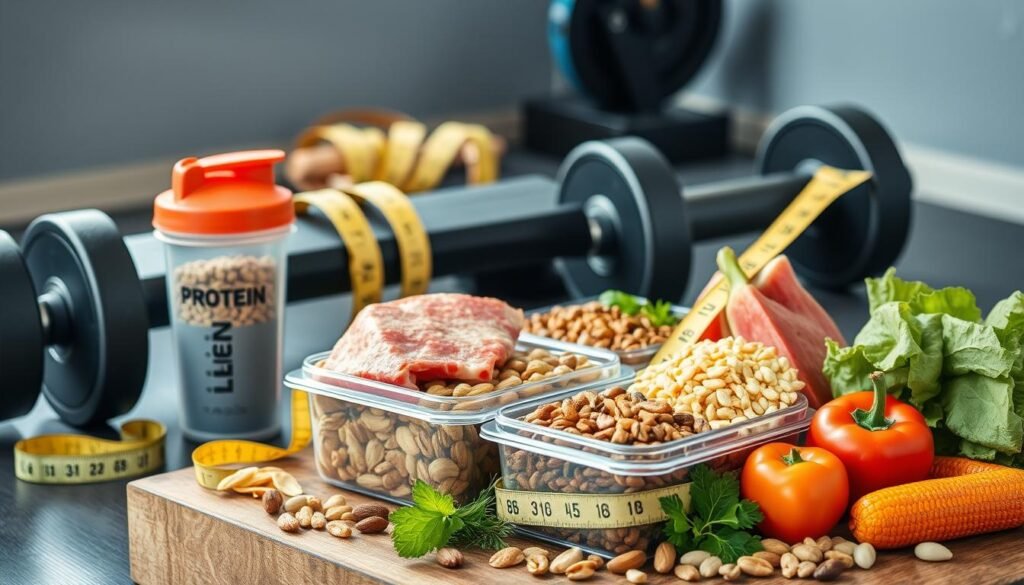Did you know a smart bulking phase could add up to 30 pounds in three months? But, bulking up is more than eating extra calories. It needs a smart plan covering nutrition, workouts, and rest. This way, you grow muscles while keeping fat low. We’re here to share top bulking tips and muscle-building advice. You’ll achieve the physique you want without hurting your health.
Did you know adding 300 to 500 more calories a day is crucial? But it’s not just about eating more. You need the right mix of proteins and other nutrients. Eating nutrient-rich foods at the right times and the right workouts matters too. Whether you’re new and want to gain 2.5 pounds of muscle a month, or you’re more seasoned looking for advanced tips, this guide has you covered.
Key Takeaways
- Target 300-500 extra calories each day for muscle growth.
- Make sure you eat 1.5-2g of protein per kg of your weight to help muscles grow.
- Eat every 2-4 hours to keep energy up and recovery on track.
- Add healthy fats, nut butters, and drinks with calories for more energy.
- Do compound lifts to work many muscles at once and improve hormone levels.
For more tips on making a meal plan that supports bulking, check this out: this useful guide. Following these ideas can set anyone on a path to significant muscle gains.
Understanding the Basics of Bulking
Bulking is a detailed way to gain muscle mass. It mixes diet and lifting weights. It’s about eating more calories than you burn. This helps your muscles grow with the extra calories.
What is Bulking?
Bulking feeds the body to grow muscles. You eat more than usual in a smart way. This helps make muscle out of the extra food. A good goal is eating 500 extra calories a day. This avoids too much fat gain. Also, eating 1.3-1.8 grams of protein per kg of your weight is key. For someone who weighs 80 kg, that’s about 104g to 144g a day. Adding weight training makes the plan work better.
Different Types of Bulking: Dirty vs. Lean
There are two main bulking types. Dirty bulking means eating a lot more calories. But, it doesn’t care about food quality. This might cause more fat gain. It can make cutting weight harder later. Lean bulking focuses on eating better and not just more. It aims for quality food and a slight calorie increase. This helps gain muscle without too much fat. Lean bulking takes time but offers lasting results.
Importance of a Caloric Surplus for Muscle Growth
To grow muscles effectively, you need a caloric surplus. This means eating more calories than your body uses. It helps muscle fibers repair and get stronger. The calories needed vary by person, due to differences in weight, height, age, and how active they are. Having more calories helps your body build up muscle mass.
Finding Your Caloric Needs
The Mifflin St. Jeor equation can figure out how many calories you need. It’s quite accurate. For example, a man weighing 175 pounds might need 250–500 extra calories a day. A woman weighing 135 pounds could need 200–400 extra calories for bulking. Knowing these numbers helps you understand what your body needs to gain weight healthily.
Strategies for Achieving a Caloric Surplus
Eating high-calorie, nutritious foods is key for bulking. Focus on foods like chicken breast, white rice, and healthy fats. Try to eat every 2-4 hours to keep up your calorie intake. Aim for a balance of 40-60% carbs, 25-35% protein, and 15-25% fats in your diet. By following these bulking strategies, you can gain muscle without too much fat. This makes your bulking more effective.
Nutrition for Size Gains
Nutrition is key for growing muscles and increasing size. It’s about finding the right mix of important nutrients. These help boost your performance and progress. Let’s talk about what your muscles need and picking the right foods.
Key Macronutrients for Muscle Building
Three main nutrients are crucial for bulking up: protein, carbs, and fats. You should get 1.5-2 grams of protein for each kilogram you weigh. This helps your muscles grow. Carbs are your main energy, important for powering your workouts. Healthy fats should make up about 20% of the calories you eat. They’re key for hormones and overall health.
Choosing Nutrient-Dense Foods
Finding foods full of nutrients is vital for size gains. Eat whole grains, lean proteins, fruits, and veggies for the right vitamins and minerals. Doing so gives you energy too. Some good, cheap options include:
- Canned beans and legumes
- Frozen fruits and vegetables
- Eggs and low-fat dairy
- Lean cuts of meat like chicken breast and turkey
By focusing on these foods, you can get what you need without spending too much. Want more muscle-building advice? Check out this resource.
Effective Bulking Strategies
Using smart bulking strategies can really boost your muscle size. It also helps you hit your calorie targets well. Eating often is key here. Having food every few hours keeps your energy up. It also keeps your muscle-building processes active. By eating regularly, you won’t feel buried under huge meals but will still get all the calories you need.
Meal Frequency: Eating Every Few Hours
Eating every 2–4 hours lets you fit in lots of healthy food. You can have three main meals and 2–4 snacks full of nutrients. Taking in protein, about 20 g every 3–4 hours, helps your muscles grow. To grow muscles, you need to eat more—about 10–20% more calories than usual.
The Role of Liquid Calories in Bulking
Liquid calories are an easy way to meet your calorie goals. Smoothies and protein shakes pack energy and nutrients without making you too full. Drinking your calories is simpler than eating big meals sometimes. For example, a glass of whole milk adds 150 calories easily. Adding drinks like these helps bodybuilders eat enough to grow bigger muscles.

| Food Item | Calories | Protein (g) |
|---|---|---|
| Whole Milk (1 glass) | 150 | 8 |
| Pasta (1 cup) | 200 | 7 |
| Beans (1 cup) | 250 | 15 |
| Oats (1 cup) | 150 | 6 |
| Dark Chocolate (1 oz) | 170 | 2 |
By following these bulking tips, like eating often and using liquid calories, you’re on the path to great muscle gains.
Bulking Hacks to Maximize Gains
To build muscle effectively, it’s smart to use certain bulking hacks. These help with eating more calories and absorbing nutrients well. Healthy fats are key in a good bulking diet. They let athletes increase calories easily without feeling too full. Adding these fats makes meals tasty and helps maintain energy for workouts.
Add Healthy Fats to Your Diet
Adding fats to your meals makes bulking better. Fats have the most calories per gram, at 9. This helps you eat more calories than you burn, which is needed for building muscle. Examples like avocados, olive oil, and nuts are great for healthy fats. Just a tablespoon of olive oil can add about 120 calories. So, you can eat more calories without making meals bigger. This is very helpful when you’re trying to bulk up.
Utilizing Nut Butters and Nuts for Extra Calories
Nut butters are great for adding calories and flavor. You can spread them on bread or mix into smoothies. Two tablespoons of peanut butter add about 200 calories. Add this to whole grain bread for another 200 calories. This snack is simple but really helps. Eating a variety of nuts like almonds or walnuts also increases calories. Just a small handful can give you 160 to 200 calories.
Look at this example of a day’s meals with healthy fats:
| Meal | Calories | Estimated Cost |
|---|---|---|
| Breakfast (Oatmeal with Nut Butter and Banana) | 1,530 | $3.20 |
| Lunch (Grilled Chicken with Olive Oil and Quinoa) | 1,750 | $3.50 |
| Dinner (Pasta with Tomato Sauce and Ground Turkey) | 1,330 | $2.80 |
| Anytime Snack (Mixed Nuts and Whole Milk) | 380 | $0.72 |
| Grand Total | 4,990 | $8.72 |
Gaining Muscle Through Resistance Training
To gain muscle effectively, it’s key to include resistance training. This training type boosts muscle size and increases strength and fitness. Success comes from combining compound lifts and diverse training strategies.
Importance of Compound Lifts
Compound lifts are vital in building muscle with resistance training. Moves like squats, deadlifts, and bench presses work many muscles at once. Doing these exercises boosts hormone levels, aiding muscle growth.
A routine focusing on these lifts helps you bulk up faster and hit your goals.
Types of Resistance Training Programs
Different resistance training programs cater to various needs. Each has its own focus and advantages. Popular types are:
- Progressive Overload: Slowly upping weights to constantly challenge muscles.
- Periodization: Cycling training intensity and volume to keep growing.
- Circuit Training: Moving through exercises to boost endurance and strength.
- Split Training: Working specific muscle groups per session for better recovery.
Choose a resistance training plan that matches your goals and abilities for the best gains. Aim for 5-7 key exercises, mixing compound and isolation movements, during sessions.

| Resistance Training Program | Focus | Benefits |
|---|---|---|
| Progressive Overload | Increase weights over time | Builds strength and muscle mass |
| Periodization | Vary intensity and volume | Prevents plateaus, enhances performance |
| Circuit Training | High-rep, varied exercises | Boosts endurance along with strength |
| Split Training | Target specific muscle groups | Allows for recovery, maximizes growth |
Gaining muscle with resistance training is about smart strategies. Focus on compound lifts and the right program for muscle and strength. This approach helps those bulking up succeed.
Timing Your Nutrients for Optimal Results
Timing nutrients right is key to better performance and faster recovery during bulking. It’s important whether you want to grow muscle or just have more energy. We’ll look at when to eat certain foods to hit these goals.
Pre- and Post-Workout Nutrition
To see the best results, eat a meal with carbs and protein before working out. This meal gives you the energy and muscle support needed. Aim to eat it 60 to 150 minutes before exercising.
After exercising, focus on high glycemic index carbs to refill glycogen stores. This helps you recover and get ready for the next workout.
The Science of Carb Timing
Getting carbs at the right time boosts energy and helps with recovery. Eating carbs around your workouts is best for replenishing glycogen. Studies show glycogen fills up faster if you eat 30 to 60 minutes after exercising.
Here is a table summarizing recommended nutrient intake and timing:
| Time | Nutrition Type | Recommended Intake |
|---|---|---|
| Pre-Workout (60-150 min before) | Carbohydrates | 30-60 g |
| Pre-Workout (60-150 min before) | Protein | 20-40 g |
| Post-Workout (within 60 min) | Carbohydrates | 40-80 g |
| Post-Workout (within 60 min) | Protein | 20-30 g |
Understanding nutrient timing helps you get the most out of bulking. It ensures effective muscle growth and top-notch performance.
Rest and Recovery During a Bulk
Getting bigger muscles during a bulk isn’t just about food and workouts. It also needs a lot of rest and recovery. When bodybuilders work too hard, they might overdo it. This can stop muscles from growing and cause injuries. Knowing how to rest and taking days off is key to getting bigger and stronger.
Understanding Overtraining and Muscle Recovery
Overtraining happens when you train too much without resting enough. You might feel really tired, perform worse, and get hurt more easily. To avoid this, it’s important to take rest days. These breaks help your muscles heal and grow, making you stronger for your next workout. Rest is just as important as lifting weights for building up your muscles.
The Importance of Sleep for Muscle Growth
Good sleep is super important for muscle growth. When you sleep well, your body releases growth hormones that fix and build your muscles. If you’re trying to bulk up, aim for 7 to 9 hours of sleep a night. This helps your body recover and keeps your hormones balanced for growing bigger muscles. To bulk up, your body needs about 1,500-2,000 extra calories, so everything, including sleep and food, must work together. For more tips on gaining muscle, visit this website.

| Recovery Strategies | Benefits |
|---|---|
| Scheduled Recovery Days | Prevents overtraining and injury |
| Quality Sleep (7-9 hours) | Enhances muscle recovery and hormone release |
| Hydration | Supports overall recovery and performance |
| Gentle Movements (Walking, Yoga) | Promotes muscle recovery without strain |
Monitoring Progress and Adjusting Your Diet
Bulking up the right way means keeping an eye on your progress. It means changing what you eat to reach your goals. By setting goals you can actually achieve, you avoid gaining too much fat and build muscle instead. A good target is adding about 0.25–0.5% of your body weight each week. For someone who weighs 175 pounds, this means a weekly gain of roughly 0.4–0.8 pounds.
Setting Realistic Weight Gain Goals
It’s important to have clear weight gain goals when you’re bulking up. Eating 10–20% more calories than you normally would helps you grow muscle effectively. If you usually eat 2,000 calories a day, aim for 2,200–2,400 calories instead. Also, getting enough protein is key. Aim for 0.7–1 gram per pound of your weight. That’s about 120–175 grams of protein for a 175-pound person.
Tracking Changes in Body Composition
To really understand your bulking progress, you need to keep track of muscle vs. fat. Regularly updating your calorie needs is a must. Try adding 100–200 calories more each week based on your progress. Eating the right balance of proteins, fats, and carbs gives your body the energy it needs. Don’t forget to drink 8–10 cups of water every day, especially when you’re training hard.
| Weight Gain Goals | Weekly Progress | Required Caloric Intake |
|---|---|---|
| 175 pounds | 0.4–0.8 pounds | 2,200–2,400 calories |
| 180 pounds | 0.45–0.9 pounds | 2,300–2,500 calories |
Conclusion
Embracing effective bulking hacks offers a way to gain muscle through nutrition, training, and rest. Knowing how many calories you need is key. You should eat about 250-500 more calories for the best results. This helps avoid the pitfalls of dirty versus clean bulking.
Monitoring your progress is very important in a bulking plan. A lean bulking phase usually lasts 4-6 months, followed by 3-4 months of cutting. By keeping an eye on body changes and adjusting your food, you avoid too much fat. This shows why it’s crucial to stay consistent and eat well.
Successful bulking needs a full approach, focusing on more than just extra calories. It’s about eating healthy, sleeping enough, and working out right. With a balanced plan, you can start your bulking journey. This will turn your muscle growth and fitness goals into reality.